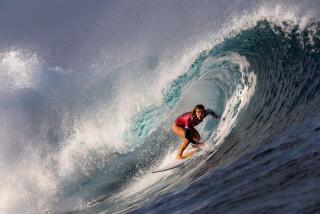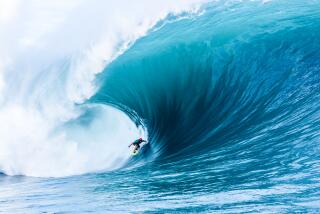Surfing still shapes the life of a landlocked Gerry Lopez
One of surfing’s most famous tube-riding icons makes his home not in a balmy, palm-lined paradise but in central Oregon.
But Gerry Lopez, 60, still answers the siren call of the ocean.
A master at the notorious Banzai Pipeline on the North Shore of Oahu, one of the world’s most dangerous breaks, Lopez says he continues to surf “pretty much any time it looks good,” even though doing so requires making the four-hour drive between his home in Bend and the distant waves off Pacific City.
“It’s not the Pipeline,” he says, “but it can be pretty fun.”
Revered within the sport for navigating Pipeline’s treacherous barrel-shaped breakers with a signature soulful detachment, Lopez moved his family from his native Hawaii about 15 years ago after shuttling back and forth for years.
“When our son started the first grade, we kind of had to settle into one or the other,” Lopez says of his family of three, including wife Toni and son Alex. “So we tried Bend and we’ve been here ever since.”
Do other surfers find it odd to spot him off the coast of Oregon?
“They do,” he says. “I don’t.”
His son, now a college sophomore, prefers snowboarding to surfing, his father says, and Lopez frequently joins him on the slopes.
“I enjoy snowboarding a lot,” says Lopez, whose home on the eastern edge of the Cascades is only about 15 minutes from Mt. Bachelor ski resort. “But surfing is and always will be the foundation of pretty much everything I do.”
Lopez, who helped launch the Lightning Bolt brand of surfboards in the 1970s, still shapes boards. Either as an actor or playing himself, he has appeared in numerous surfing movies and documentaries, and in 1982 he co-starred with Arnold Schwarzenegger in “Conan the Barbarian.”
A collection of his short stories about surfing was published last spring, and he works as an ambassador for Patagonia clothing company.
“I test their winter gear,” he says, “and their surf gear.”
One of surfing’s most prestigious contests, the Pipeline Masters, was renamed in honor of Lopez, who not only made the break famous but won the event in 1972 and 1973.
Lopez returns to Hawaii each December to dole out the awards. (This year, one of the prizes was a Lopez-designed surfboard that event winner Kelly Slater, a nine-time world champion, said he would “cherish.”)
It has been years, though, since Lopez last surfed Pipeline.
Too crowded, he says.
“All my earlier experiences were so much better,” Lopez notes. “I came to the realization that I could enjoy it more just watching from the beach. The level of surfing has really gone through the roof from what it used to be in my day, and the younger guys are so much more skilled than any of us ever were. There are a lot of girl surfers nowadays that surf better than I ever dreamed of surfing.”
A Hawaii state champion at age 14, Lopez grew up a “town guy” in Honolulu, son of a news editor for the Honolulu Advertiser. From an early age, though, he was a regular at the now-famous breaks only about an hour away.
Back in those days, Lopez said, “nobody called it the North Shore. We called it the country, and it was about as close to heaven on Earth as any of us could ever imagine.”
Unimaginable to Lopez, whose seeming nonchalance in the tube created a signature aura about him, was the coming explosion in surfing’s popularity, a cultural phenomenon that vaulted the sport squarely into the mainstream.
“When I started, the only industry was guys who built surfboards,” he says. “There weren’t clothing companies or anything like that, like there are now. None of us had any idea of what was to come. We just thought it was kind of an obscure, underground sport that weirdos like us liked. . . .
“It was growing the whole time we were doing it, but our only thought was that more guys would be wanting waves, which meant less waves for us.”
This realization led to Lopez’s becoming a pioneer in surf exploration, an endeavor that led to the discovery of now-legendary breaks in Bali and other Indonesian locales that Lopez still visits on his numerous surf trips.
“I’ve had a great time,” says Lopez, whose latest adventure, on behalf of autism awareness, involved navigating a stand-up paddleboard around Manhattan the last two summers. “I wouldn’t change it for anything.”
He says he can’t envision a time when he won’t surf.
“I’m still as passionate as I ever was -- I think that’s just the nature of surfing,” Lopez says. “I was 10 years old and it was a recreation, and then after I’d been doing it for six or seven years, I understood how difficult it was to learn and I decided it was one of those things that would be a lifetime endeavor.
“To this day, I find lessons to be learned in the surf.”
In Oregon, Lopez found one that’s the title of his book: “Surf Is Where You Find It.”
--
More to Read
Sign up for The Wild
We’ll help you find the best places to hike, bike and run, as well as the perfect silent spots for meditation and yoga.
You may occasionally receive promotional content from the Los Angeles Times.






